Mound Key Archaeological State Park, Florida
This is another in my continuing series on Florida State Parks or to borrow their motto, The Real Florida, with which I have to agree. I’ve been coming to SW Florida for almost 40 years and have been fascinated with the history of the Calusa Indians, who once called this area their home for well over a millennia. That wasn’t always the case. Before my first trip to Florida I’d heard of the Seminoles, Creeks and the Miccosukee, but it wasn’t until I first walked the Shell Mound Trail in Ding Darling N.W.R. on Sanibel that I encountered the name Calusa. Since then I’ve been seeking out Calusa sites wherever possible, including the amazing Calusa Heritage Trail on Pine Island. However, there was one spot that I always had my eye on, but was never able to get to – that is until this week. That spot is Mound Key in Estero Bay. Here’s why I wanted to get there and how I managed to do it. You can too.
Who Were the Calusa Indians?
The reason that most people outside of SW Florida have never heard of the Calusas is that they no longer exist and haven’t for centuries. Like many other Western Hemisphere aboriginal societies, the Calusas were unable to withstand the onslaught of disease, slavery (often inflicted by other native tribes), warfare and intermarriage that the coming of the Europeans brought to the New World. In just over two hundred years from their first contact with Ponce de Leon in 1513, the Calusa, once a mighty force, were no more.
The Calusa occupied an area that ran roughly from Port Charlotte Harbor to the Florida Keys and their method of living was quite different, if not unique among North American Indian tribes. They were called the Shell Indians because they used sea shells and their occupants for almost every conceivable purpose. They ate them, made weapons, tools and jewelry from them and most importantly, used shells to create their own distinct environment on which to build their structures. I must admit that when I first learned of Calusa shell mounds on that day in Sanibel, I just assumed they were kitchen middens, ancient garbage dumps, which are found throughout the world. These middens are valuable sources of knowledge for archaeologists, but there are limitations as to what you’re going to find in other people’s rubbish.
While some of the smaller shell mounds in SW Florida are indeed middens, the great mounds like the ones on Pine Island and on Mound Key, were deliberately made to create an elevated surface which over hundreds of years grew higher and higher. The Calusa were not hunter gatherers in the traditional sense, nor were they agriculturalists like the other Florida tribes. Instead they got almost everything they needed from the abundant waters of SW Florida, particularly the estuaries. They were expert fishermen, using spears, nets and fish traps. What they couldn’t get from the sea they obtained from other tribes by way of tribute or barter. The name Calusa apparently means ‘fierce’ or the fierce people and from the descriptions of early Europeans it appears that they did hold sway over a much larger area than just SW Florida.
Here’s a replica of a Calusa weapon made from the teeth of a tiger shark. How’d you like to have that at your throat?
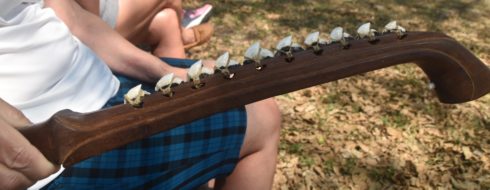
Why is Mound Key So Important?
There are dozens of islands in Estero Bay and from the water they pretty well all look the same – mangrove lined and virtually inaccessible. However, if look look at an aerial photograph of Mound Key you can see that it’s different from it’s neighbours. There are clear signs of human intervention indicated by by the white spots and the straight lines present on Mound Key. The fact is that this was once the city of Calos, capital of the Calusa nation and home of the cacique or Calusa king. Imagine that; in a part of the state where history seems almost an afterthought to the natural attractions and great weather that attract millions of visitors a year there is a remnant of an ancient and mostly forgotten kingdom literally right in the middle of it all. Who wouldn’t want to visit this place of mystery and discover a vanished civilization?
However, getting to Mound Key is not that simple. It is completely surrounded by a mangrove swamp and finding the tiny entrance will perplex even the most experienced of boaters. Add to that the fact that one can only approach this entrance way on a high tide and you’ve got yourself one well protected island. It’s almost as if the Calusa’s somehow put a curse on the place that make sure it’s ancient secrets remain undiscovered. That’s why I was really excited to read in the illustrious Fort Myers Beach Observer that Mound House, in conjunction with Fish Tale Marina, was offering a twice monthly tour to Mound Key. Alison and I immediately signed up for the next excursion. What follows is a description of what to expect if you want to visit Mound Key and you damn well should.
Mound House, Fort Myers Beach
The Mound Key tour is divided into two distinct parts, both of which are essential to understanding and enjoying the visit to Mound Key. The departure point is Fish Tale Marina on the southern side of Estero Island which on the day we went was having an amazing $15.00 sale on a lot of really nice Columbia clothing items. Alison picked up a pair of slacks similar to ones she had paid over $80.00 for back in Canada. The tour is scheduled to run about three hours and is timed to coincide with the highest tides of the month. The cost is $55.00 which includes the $10.00 admission fee to Mound House. The boat is the Estero Bay Express which is a large pontoon boat with a captain and two mates. Also on board was Penny Jarrett, a very experienced guide, knowledgable not only about the Calusa culture, but also the flora and fauna of SW Florida.
After boarding the boat we and about a dozen others, headed for the first stop, Mound House on Fort Myers Beach. Mound House is notable for a number of reasons. Not only is it the oldest building on Fort Myers Beach, dating all the way back to 1921 (sarcasm intended), it sits atop a Calusa shell mound that dates back 2,000 years. The trip from Fish Tale Marina took about twenty minutes and was a pleasure in itself. Along the way Captain Justin pointed out this small key where frigate birds have taken up nesting in recent years. This is a major development as previously they have only be known to nest on the very isolated Marquesas Keys and since 1988, the Dry Tortugas.
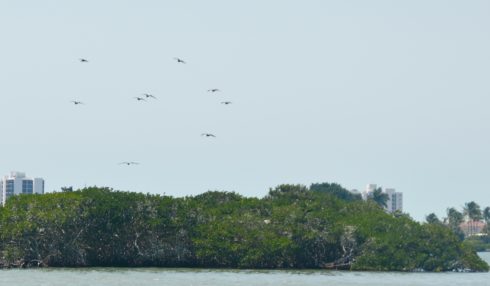
Approaching Mound House you can see that it is a very interesting looking dwelling on what, by Florida standards, is an elevated site. There’s also a massive strangler fig that dominates the landscaped lot.
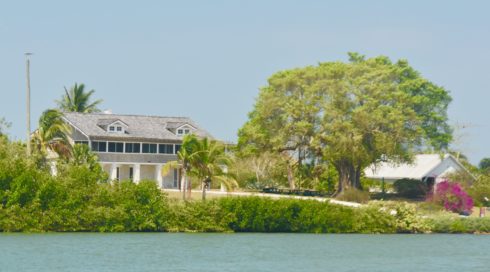
This picture gives a better idea of the elevation. Alison took it from the landing.
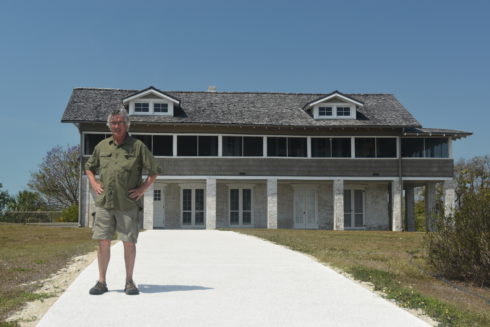
Mound House serves as a museum that features three distinct time periods in the history of Estero Bay – the Calusa Indians, the Cuban fisherman who followed them and finally the Koreshan Unity period from which Mound House dates. Since the purpose of this trip was to focus on the Calusas and Mound Key, Penny restricted her commentary to that period. We started by visiting an underground excavation which allowed us to see the interior of a shell mound and appreciate just how much the Calusas had built up the land just by using shells.
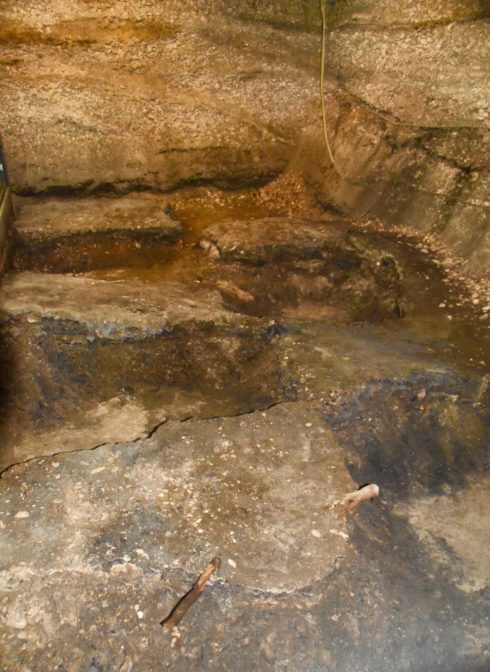
What you are looking at here is the original ground level and the layers of shells that elevated the site by some 14 feet, a mountain by SW Florida standards. I know the picture doesn’t look that exciting, but as far as I know, it is the only place you’ll ever be able to experience a shell mound from the inside.
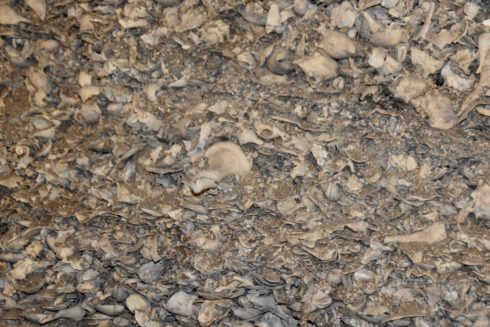
Also in this underground room is a very good mural depicting the Calusa way of life, which before the coming of the Europeans, looked pretty Edenic.
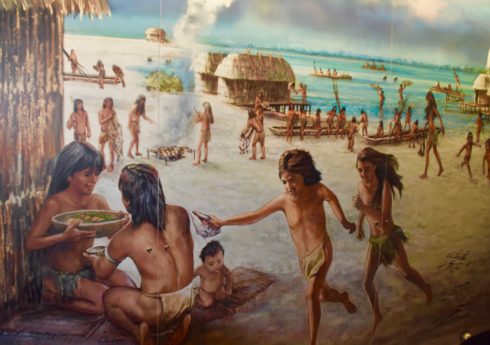
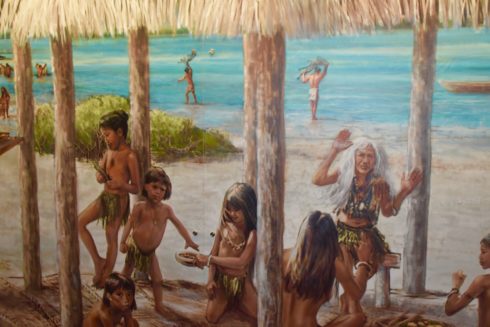
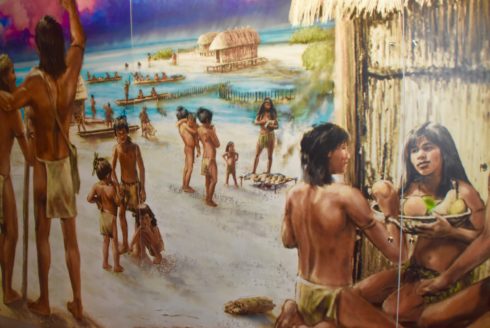
After visiting the underground room we walked along the path to the giant strangler fig where Penny showed us replicas and some originals of Calusa objects that had been excavated at Mound House and other Calusa communities.
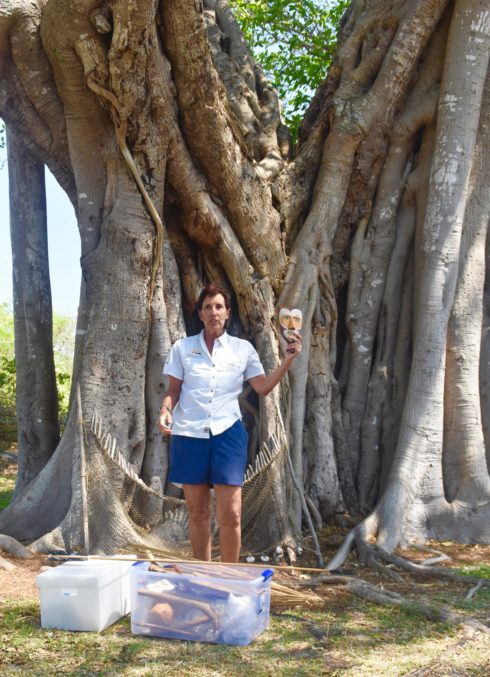
The Calusas were expert wood carvers as well as implement makes. This is a tool made from a lightning whelk that could double as a weapon.
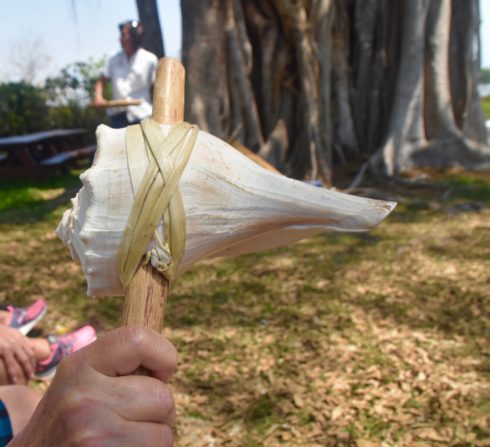
We did not visit the inside of Mound House on the tour, but we could come back at any time as the admission fee was included in the tour. Alison and I did return the next morning and I’m glad we did.
This is the living room restored to look exactly as it did in 1921 when it was owned by the Case family, members of the Koreshan Unity religion. The Koreshans are a unique SW Florida story in themselves and you can read my post on them here. There are parts of the house that predate the 1921 version, but this arts and craft style is always one that stands up over time.
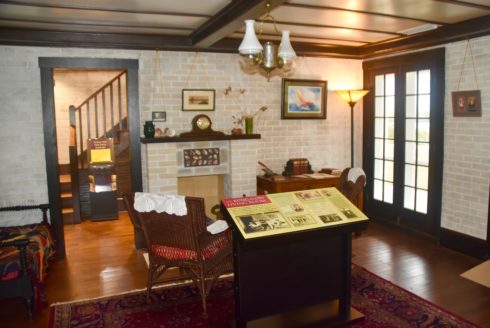
Upstairs is the Calusa room which displays many Calusa artifacts and interprets the history of the Calusa people.
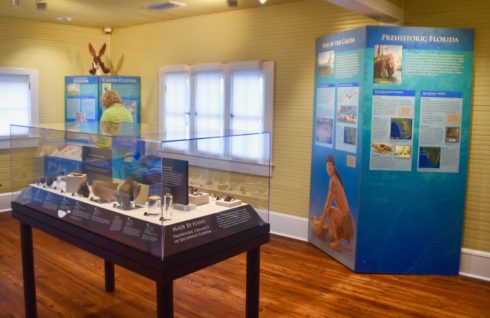
As I mentioned, the Calusa were great woodworks as these replica artifacts demonstrate.
This is the Key Marco cat, a half human half Florida panther figurine that was found during an archaeological dig on Marco Island in 1895-6. It is made from native buttonwood and carved between 500 and 800 A.D. The original is in the Smithsonian.
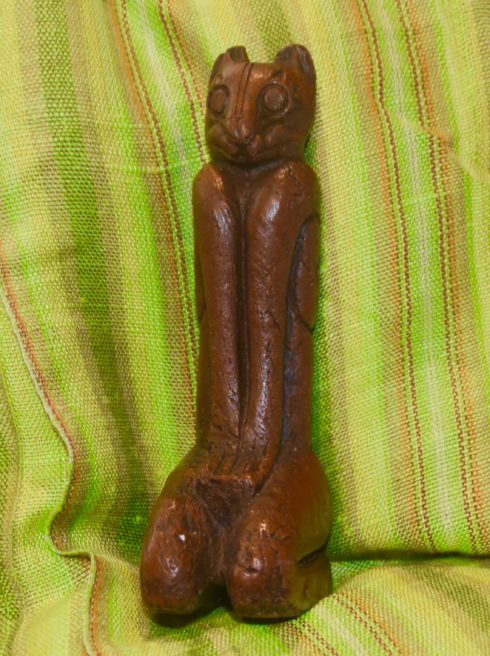
This is a drawing of a now lost Calusa painting of a woodpecker, probably a pileated, but maybe, just maybe, the probably extinct ivory billed.
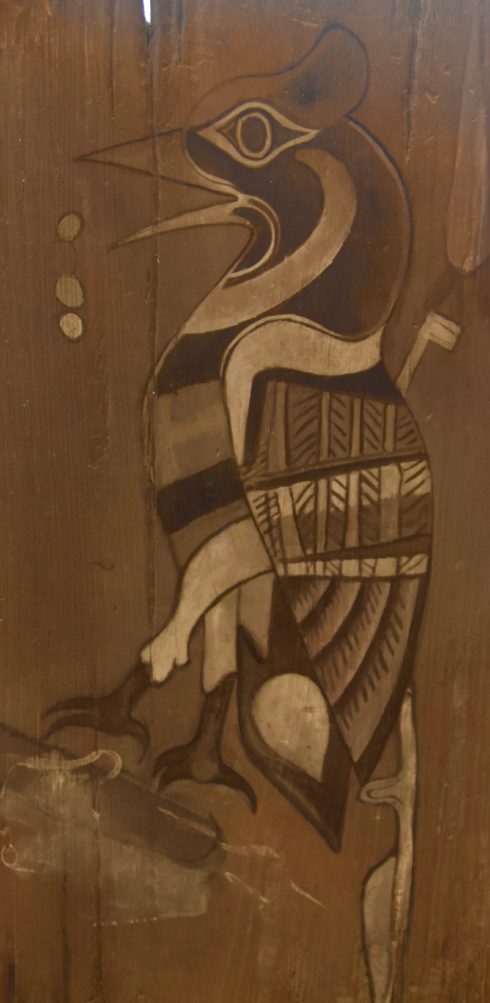
This is a Calusa deer.
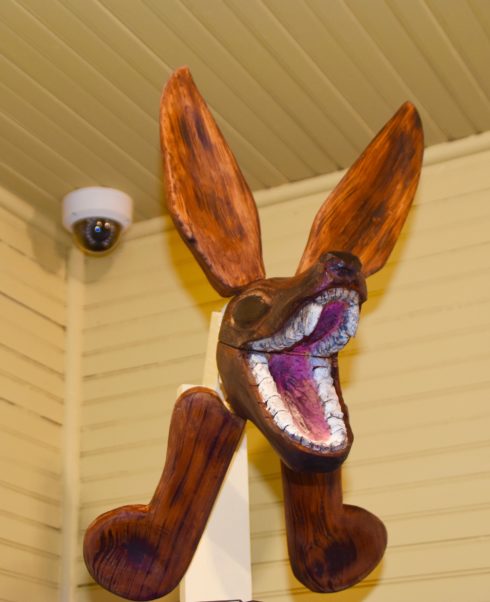
There were also Calusa representations of alligators, dolphins and other animals that would have been well known and possibly sacred to them.
The Mound House museum has a small, but really good gift shop where you can buy modern replicas of Calusa art work made by Peter Sottong of Key Marco Cat.
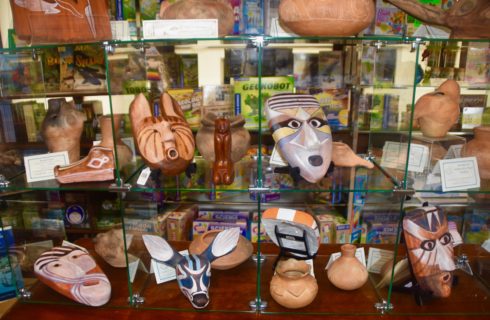
I’m proud to say that the Marco Cat in this picture will now reside on our living room mantle.
Sorry for the digression, but I wanted to make sure that if you do go on this tour that you return to visit Mound House. It was a great diversion on a very rare rainy morning.
Mound Key
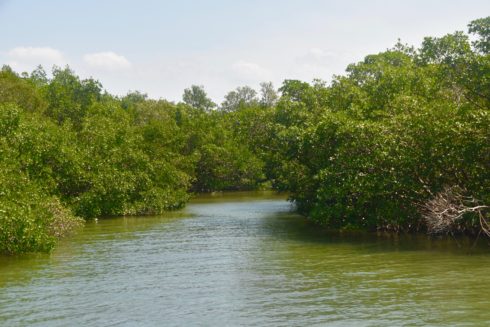
Back on the Estero Bay Express we motored out into Estero Bay and headed for Mound Key. I half expected that the island would be obvious to spot because of its elevation, but not so. The mangroves that completely surround it give one no indication from the water that Mound Key is any different from any of the other keys in Estero Bay. Also, there’s absolutely no signage directing you to Mound Key. You either know how to get here or you don’t. Thankfully Captain Justin knows that this narrow inlet in the mangroves leads to the only place on the island that you can land anything bigger than a kayak.
This is the only indication that you are in the right spot.
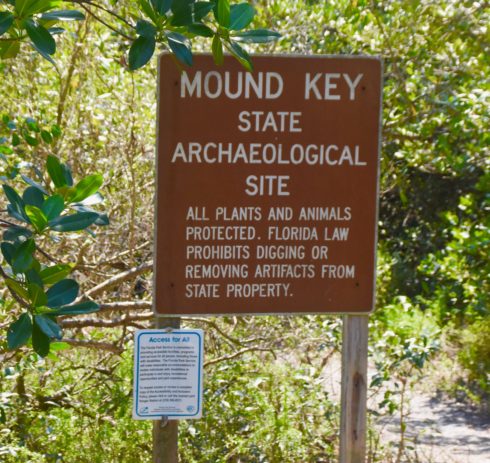
Captain Justin runs the boat up onto a small stretch of sand barely wider than the boat and we disembark with the help of a set of stairs put down by the mate. Penny then leads the way along the single file path that leads to the mounds. Mounds, you say? Again my ignorance shows as I expected Mound Key to be just one big mound. Rather there are three distinct mounds each believed to have served a separate purpose. The largest one probably held the home of the cacique while the smaller ones featured a Calusa temple and, improbably, a Jesuit mission. I say improbably because the Calusas were one of the very few native tribes that never converted to Christianity. However, Spanish records do mention a Jesuit mission on Mound Key. Here is a representation of how the largest mound might have looked when Ponce de Leon came by in 1513. It is estimated that 1,000 or more people lived on Mound Key at that time.
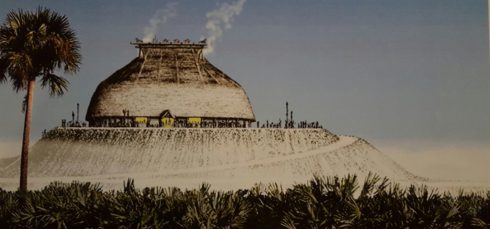
You sure wouldn’t know that from what’s left today. The reality is that a visit to Mound Key is not going to deliver a Wow moment like some archaeological sites do, however, with a little imagination it is possible to recreate in your mind what this place must have been like a 1,000 years ago.
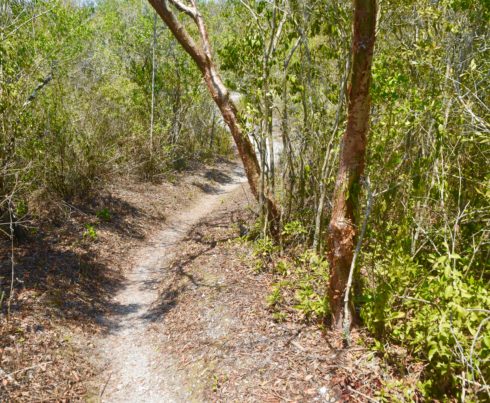
On the way to the mounds Penny points out some of the native trees and shrubs that the Calusa used to make clothing and medicines including the silk cotton tree. This is the flower.
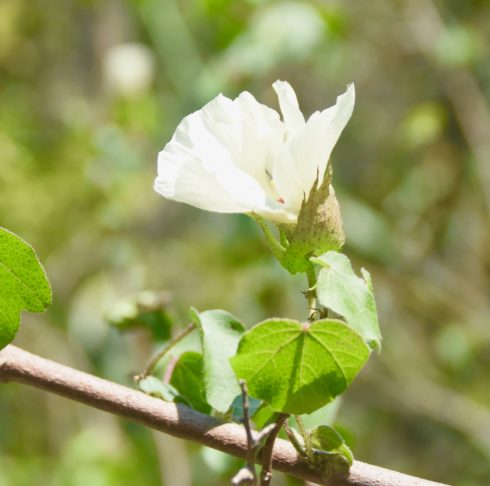
And this is the boll that develops from the flower.
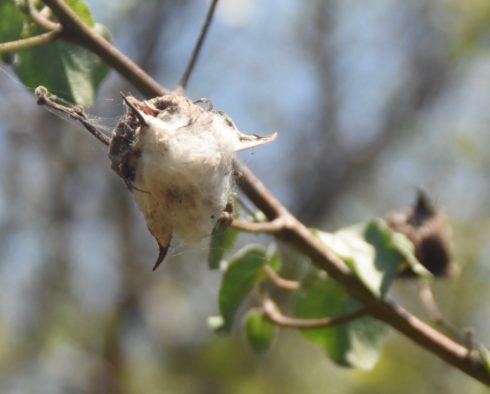
The trail is muddy in just one place for about twenty feet, but after that it starts the climb up to the first mound.
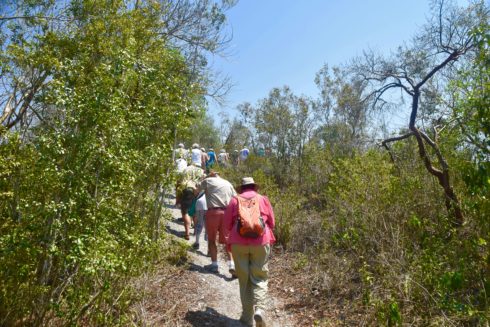
Again, by Florida standards, this is like mountain climbing. At the top there are several interpretive panels documenting the history of Mound Key. It did not end with the destruction of the Calusa empire. First there was an occupation by Cuban fishermen or ranchos that lasted a couple of hundred years and then a brief period of homesteading by Koreshans from the nearby Estero River settlement. Ultimately neither Europeans or new Americans could recreate the successful living environment that had been maintained by the Calusas for over 1,000 years.
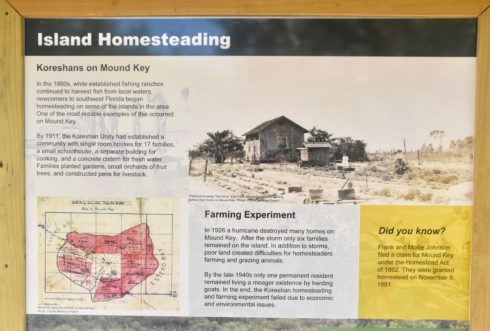
Today, looking over the island from the highest mound it looks like a bleak and forbidding land.
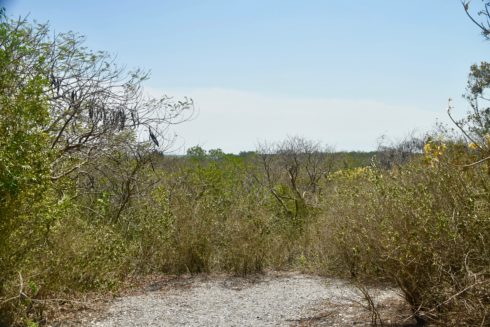
This is the one spot that you can get an appreciation of what most of Mound Key would have looked like before the vegetation took back the island.
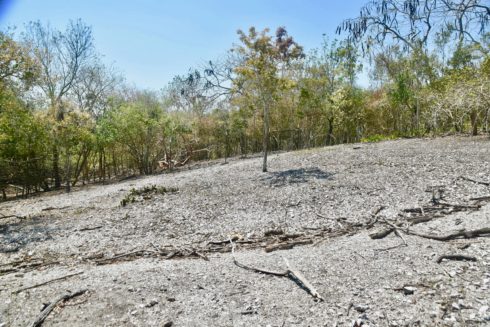
At the top Penny points out a dormant poinciana tree which in summer erupts into bright red bloom that makes Mound Key visible for miles around.
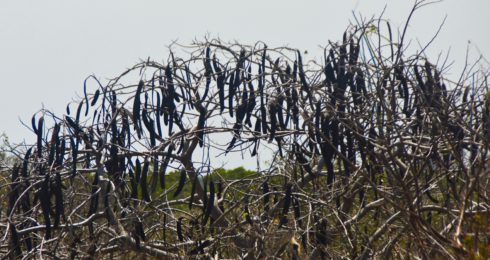
Even though it’s nearly ninety degrees, at the top of the mounds there is a cooling breeze blowing off the water. It’s actually very nice up here even if there isn’t much to see. All too soon it’s time to head back and we turn back toward the boat.
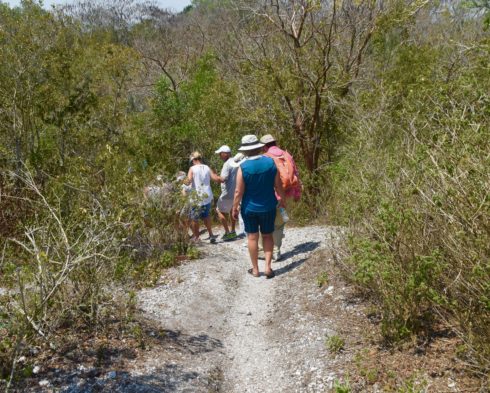
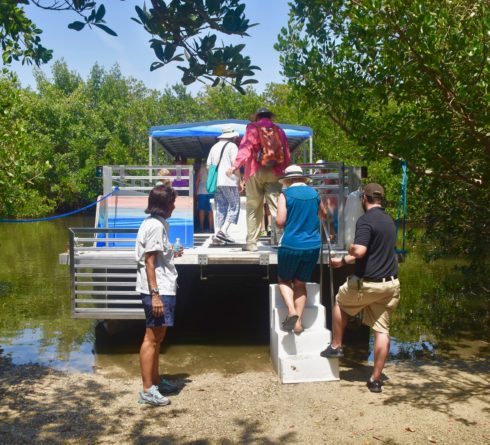
On the way back to Fish Tale Marina this dolphin obliges us by porpoising behind the boat. The Estero Bay Express specializes in dolphin sight seeing tours and we just got a sample of what to expect. I’ve just cracked open a PBR and enjoy the cold lager as a reward for finally getting myself over to Mound Key.
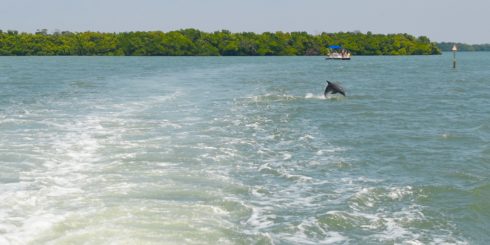
Back at the marina Alison and I both agree that it’s been a tremendously worthwhile excursion and one that anyone with an interest in archaeology or Florida history must do at least once. We’re very glad that Mound House and Fish Tale Marina have cooperated in making this possible for everyone. Check out their websites for the next tour.
If you liked this post on obscure Florida destinations you might want to read this post on Kissimmee Prairie where the last wild Carolina parakeet was shot in 1904.

